Greetings to our readers, and also Merry Christmas to those of you who celebrate that. To the rest of you, Frohe Weihnachten, Buon Natale, Joyeux Noel, Vrolijk Kerstfeest, Feliz Navidad, Buon Natale, Heri ya Krismasi, Z Rizdvom, and, of course, Hanukkah sameach u'me'or.
Now this week we thought we would have some fun by also only revealing the diary dates of the newsletter one day at a time, in the manner of an advent calendar.
It also bought me time, as I was coping with a course of tablets which made me nauseous and drowsy, and, once the course was over, gave me a body full of itchy red spots, and the firm belief that I am probably allergic to penicillin. I am only sad that I could not get the spots to flash, for I could have become a walking Christmas decoration - and probably an instant hit on TikTok....
This week there was a definite plethora of Liebigs, both in the diary dates and the cards of the day - and I owe many thanks to a reader who sent me the scans. I have to say the more I see of continental cards, the more I grow to admire them.
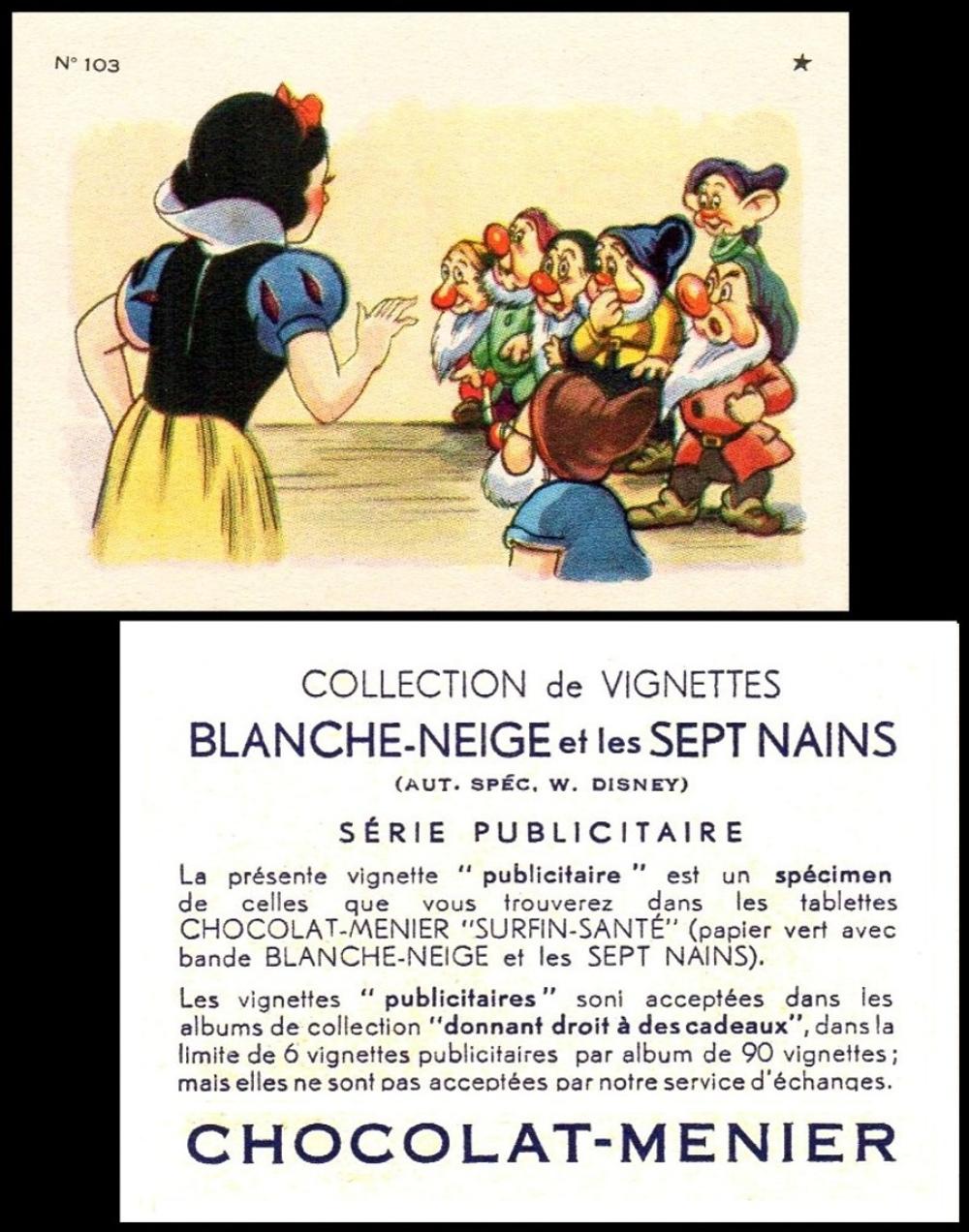
Chocolate Menier [trade ; chocolate : Paris France] "Blanche Neige et les Sept Nains" / "Snow White and the Seven Dwarfs" (1937) 103/??
So let us open the door to card number one.
This is included to mark the premiere of Walt Disney`s Snow White, which was today in 1937, and it also gives a link to the theme for the rest of this week`s diary dates.
"Blanche Neige et les Sept Nains" is indeed literally translated as Snow White and the Seven Dwarfs - except that the French put the White first before the Snow.
I have to say that it is an unusual set, because look at the front alone and you would think it came from the 1938 de Beukalear set - but it did not. For one thing that only has a hundred cards, and ours is numbered as card 103.i do not know how many cards are in this set though. Also I had a look through an entire set of those de Beukalear cards only to find this image was not part of that set. However it is very similarly drawn, so either these sets both came from artwork supplied by the Disney studio, or there was another artist who did both sets.
This set does seem to be a predecessor, or even a promotional set, It was issued in 1937, a year earlier, than the de Beukelaer one, and the text on the back even says "Serie Publicitaire".
Chocolat Menier was founded by Antoine Brutus Menier in Paris in 1816. Curiously the chocolate was a sideline, they were a pharmaceutical chemist, and, at that time, chocolate was primarily used for medicinal purposes. a pharmaceutical manufacturer in Paris, at a time when chocolate was used as a medicinal product and was only one part of the overall business. In fact chocolate has been seen as a medicine since the Aztecs and Mayans blended it with plants and fruits to cure illnesses; one of these other plants often being tobacco. And they also knew that if the concoction was unpleasant to taste, adding chocolate made it more palatable. Europe, on the other hand, were slow to find this out. It was not until 1631 that Antonio Colmenero de Ledesmo published a book on chocolate, with recipes not just for how to blend and make it into a liquid to drink, but also medicinal uses, like childbirth, coughs and consumption.
Chocolate Menier made it through two World Wars and remained a family company until 1971, when it was bought by Rowntree Mackintosh. They held it for less than twenty years though, and then they were bought, by Nestle.
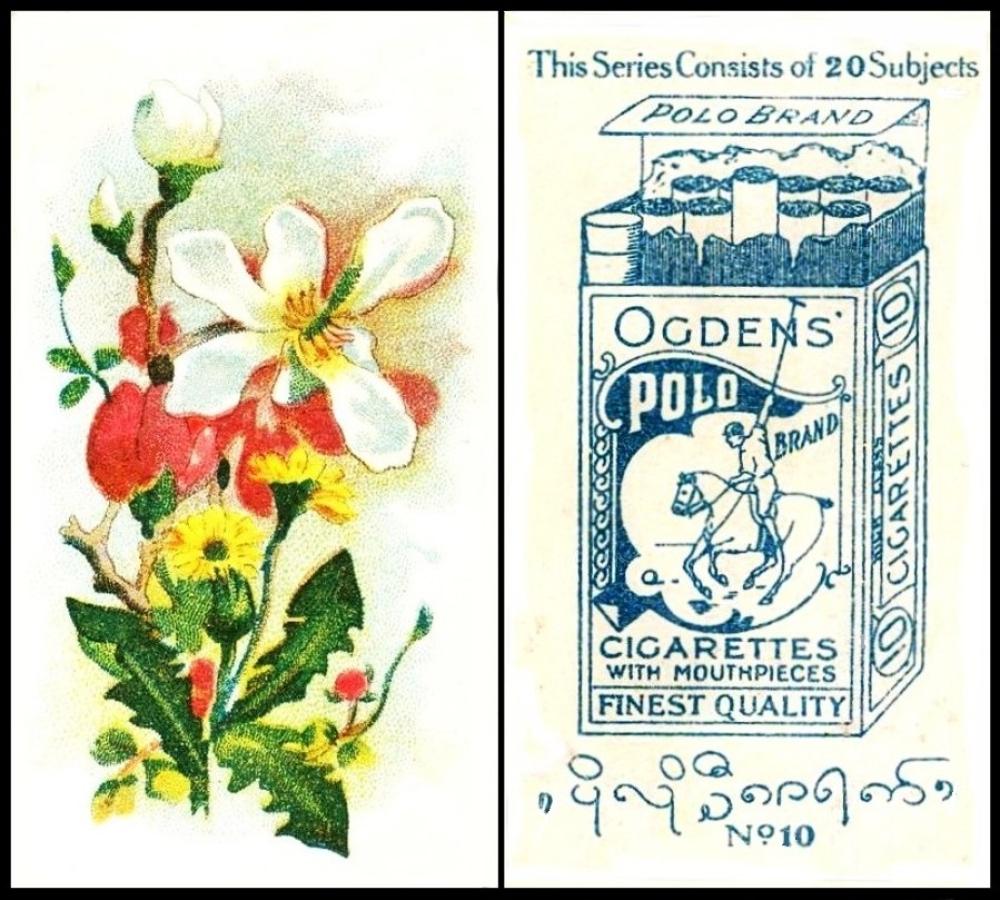
Ogdens Ltd [tobacco : UK - Liverpool] "Flowers" - "Polo" brand (1915) 10/20 - RB.115/82.A.2 : O100-750.a.2 : O/2-206.b : O/82.A.2 [RB.15/82.A.2]
The card may be kind of a tangent, but stick with me. Today is a centenary, for the Burma Agricultural College and Research Institute was founded today, in Mandalay, in 1924.
The founder was a missionary called Brayton Clarke Case, who is often quoted as being an American - though he was actually born in Rangoon. It appears that his parents, also missionaries, must have been American, for he studied at Brown University in Providence, Rhode Island, and then the University of California, which was where he studied agriculture. In 1912 he was sent to Burma as a missionary, and five years later he married. The school was founded in 1924 and became part of Rangoon University in 1938, perilously close to the outbreak of the Second World War. In fact it was bombed during the Japanese invasion of Burma in 1941, but by that time Mrs. Case had died (in September 1939), and Mr. Case was serving in the forces, in India. He sadly drowned not long after, in 1942, when the boat he was travelling across a lake in capsized. He had been on the way to buy seeds.
The University reopened after the war, but it had been badly damaged and much of the research was destroyed. Somehow it did get back on its feet and it still exists, though in 1973 it was renamed (and relocated) to Yezin Agricultural University.
As far as why we have this card, well it was issued in Burma. Also, surprisingly, flowers are part of agriculture; they are not only a crop for selling as cut flowers and seeds, but we are relearning the old practise of growing flowers and food crops together so that the flowers both attract pollinators to the food and sometimes attract pests who would instead eat the food. Flowers are also edible, and many parts of them are medicinal. Finally, at the end of the growing season, the flowers can be put in the compost bin, or ploughed into the soil to add vital nutrients.
This set is actually more complex than it appears. It is first described in our original Ogdens reference book, RB.15, issued in 1949, as :
82. 20 FLOWERS (adopted title). Size 63 x 36 m/m. Fronts lithographed in colour, no captions. Subjects illustrated in Fig.40.
A. Backs in blue, with illustration of "Polo" packet. Numbered
1. No Eastern inscription at foot, Polo packet 49 m/m high
2. With Eastern inscription at foot, Polo packet 49 m/m high
3. With Eastern inscription at foot, Polo packet redrawn, 46 m/m high
B. Plain backs, anonymous and unnumbered.Issued in the East, between 1905-15. Similar series by Wills ("Purple Mountain" cigarettes)
I will get the scan done asap.
In our original British American Tobacco booklet, RB.21, issued in 1952, the Polo sets are simply listed in the front index with a cross reference to the Ogden`s book. However it does add that the set was issued in Burma, India, Ceylon and Malaya. As for the anonymous plain back version that is listed as having been issued in 1915, in Malta, India, Malaya and the Channel Islands.
The Wills "Purple Mountain" version is only mentioned briefly, because it appears in the Wills books, which I have not brought down. It does tell us that the set was issued in two formats, numbered in 1914 and unnumbered in 1915. There is no firm statement here as to where that brand was issued, only the rather vague "in the Far East"
Our original World Tobacco Issues Index lists these as
FLOWERS (A). Sm. 63 x 36. Back in blue. Nd. (20). See RB.15/82.A ... O/2-206
(a) Back with no Eastern characters at foot, "Polo" packet 49 m/m high
(b) Back with Eastern characters at foot, "Polo" packet 49 m/m high
(c) Back with Eastern characters at foot, "Polo" packet redrawn, 46 m/m high
(and it is identical in the updated version except that the old RB.15 code is replaced with the one for the updated Ogdens book, which is RB.115).
There is no mention of the anonymous set in either the original or the updated version, for it has been moved to the back of the book in the "Z" numbers, where it appears as :
FLOWERS (A). Sm. 63 x 36. Unnd. (20). See RB.15/82.B. Issued in India, Malaya, Malta, Channel Islands through B.A.T. ... ZH2-27 (or ZH02-300 in the updated version)
There is no cross reference to the "Polo" set in either book.
The "Purple Mountain" version appears in the original World Tobacco Issues Index under Wills Section 4.E, after a heading which reads "PURPLE MOUNTAIN CIGARETTES". Issued in the Far East. 1912-15" Only two sets appear, and both have a floral theme, being "Flowers" and "Roses". The "Flowers" are listed as :
FLOWERS (A). Sm. 63 x 36. "Purple Mountain" brand issue, ... W62-322
1. Numbered on fronts. (20) See W/371
2. Unnumbered. 12 known. See W/372
Our updated version of the World Tobacco Issues Index not only adds in the header that the backs are in purple, but also renames the set, to :
CHRYSANTHEMUMS (A). Sm. 63 x 36. "Purple Mountain" brand issue, ... W675-464
1. Numbered on fronts. (20) See W/371 2. Unnumbered. (100). See RB.21/372
The problem is that my RB.21 has code 372 as "Cricketers and their Autographs", anonymously issued in South Africa, and it is followed by "Do You Know" at 373, there is not a word about Chrysanthemums. Will have to investigate that
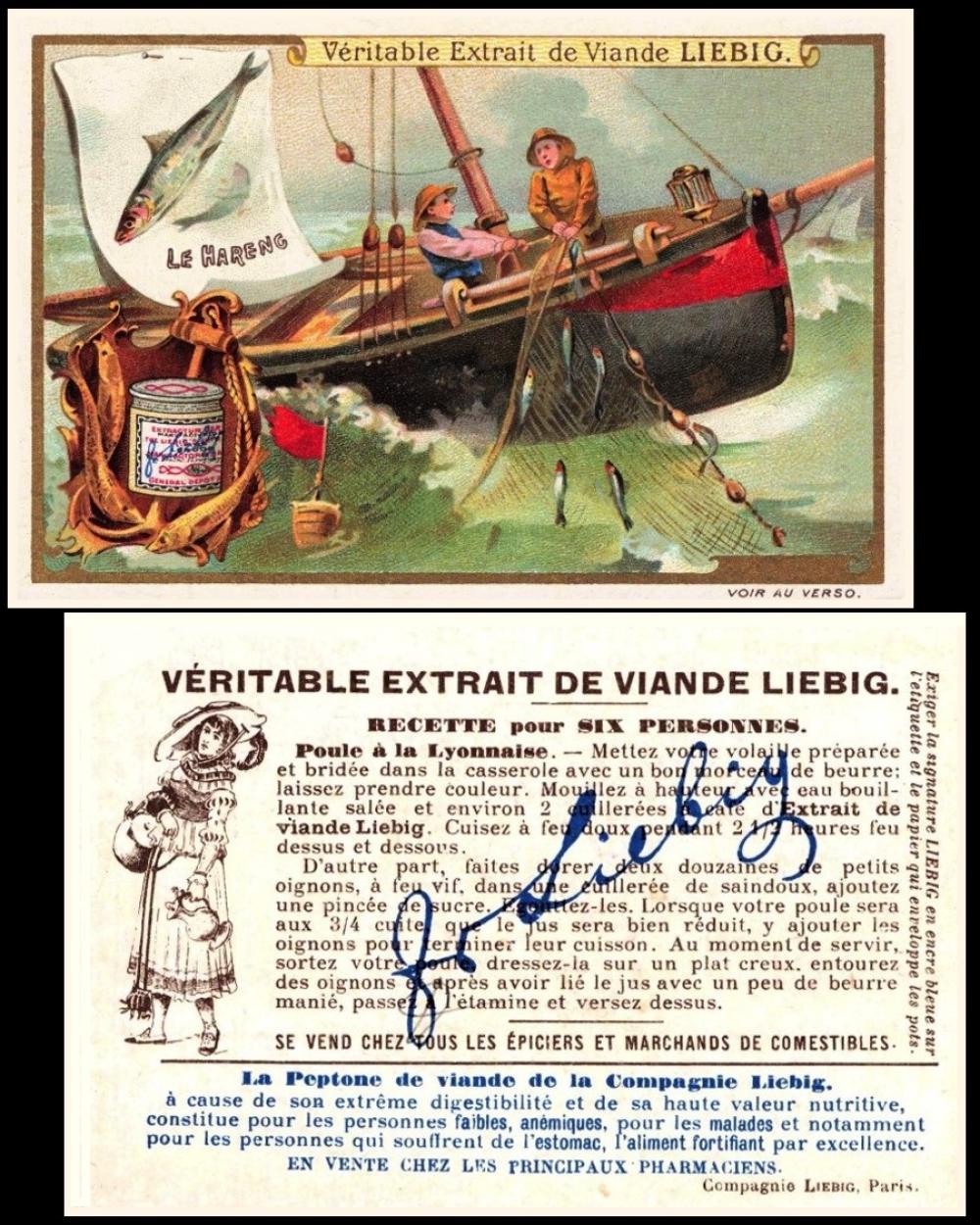
Liebig [trade : meat extract : O/S - South America] "Peche" (1899) Un/6 - F.0600 : S.0599
So as the rest of us sit down and wait for Christmas Eve, the people in Mousehole, Cornwall, will be getting ready to celebrate a local hero on that day instead. For it was on that night, ever after called "Tom Bawcock`s Eve", that a man by that name headed out to fish in a huge storm, rather than see his townsfolk starve. He did not know whether he would catch anything, or whether the fish would have all gone to ground, or even whether he would survive and find the shore again, but he went anyway, and came back with a goodly catch, to see the townsfolk standing on the shoreline with lanterns to light his way home.
And in order to make the fish feed the entire village, he is also supposed to have invented the local delicacy "Stargazy Pie", where the base of the pie is filled with potatoes and eggs, and several fish, whole, are laid on top, their heads poking out. In some versions the fish, or maybe just the heads, are poked down in slits made in the top of the crust, so they are looking up at the stars - and that, reputedly, is the origin of the name. Traditionally these fish were pilchards or sardines, but we are allowing our card of the herring because that is also a Cornish fish, and also the most common fish of the autumn and winter months, so it is very likely that the catch would have included at least a few of them.
Now for the downer though, because we do not really know if this event ever took place. It is said that it occurred during the sixteenth century, when there was indeed a long spell of bad weather which meant that no fishing could take place and as that was the main food for local people, they would have been hungering. However the first telling of the story was by Robert Morton Nance, and not until 1927. He was an author, and supposed to be the leading authority on Cornwall and its language, as well as being one of the founders of the Old Cornwall Society, for whose magazine he originally wrote this tale. Though, oddly, he was born in Cardiff, in 1873. He set the story at the start of the nineteenth century, and he was also the first person to name the brave sailor as Tom Bawcock - though not the first to use the word "Bawcock", that honour going to William Shakespeare, in the play "Henry V", written between 1598 and 1599; and he also uses it later in "Twelfth Night" and "The Winter`s Tale", each time as a term of affection to a handsome, or brave man. Now at the time Shakespeare was writing, Tom was a common name for a man whose name you did not know, much as male cats (and turkeys) are all generically still known as Toms.
Today, on this day, there is a grand lantern procession, and lots of stargazy pie, or, sometimes, just one huge one. But this form of celebration started even later, in the 1950s.
As far as our card it is one of a set of six, the others being crayfish, gudgeon, our herring, salmon, shrimp and whitefish. Most of the cards are fishing from the side of water, only ours and the whitefish showing boats.
Though it does not say so on the cards, this was actually set two.
Set one was issued in 1891, and most of the cards show fishing from boats. The reference numbers on that are F.0278 and S.0280. It was issued in France and Belgium as "Peche", and in Germany as "Fischfang".
Our set was issued in six countries, the Belgian, French and German versions having the same titles. However it was also issued in the Netherlands, titled as "Vissen", and in Spain, which I have not been able to find a title for, but it is most probably "Pesca".
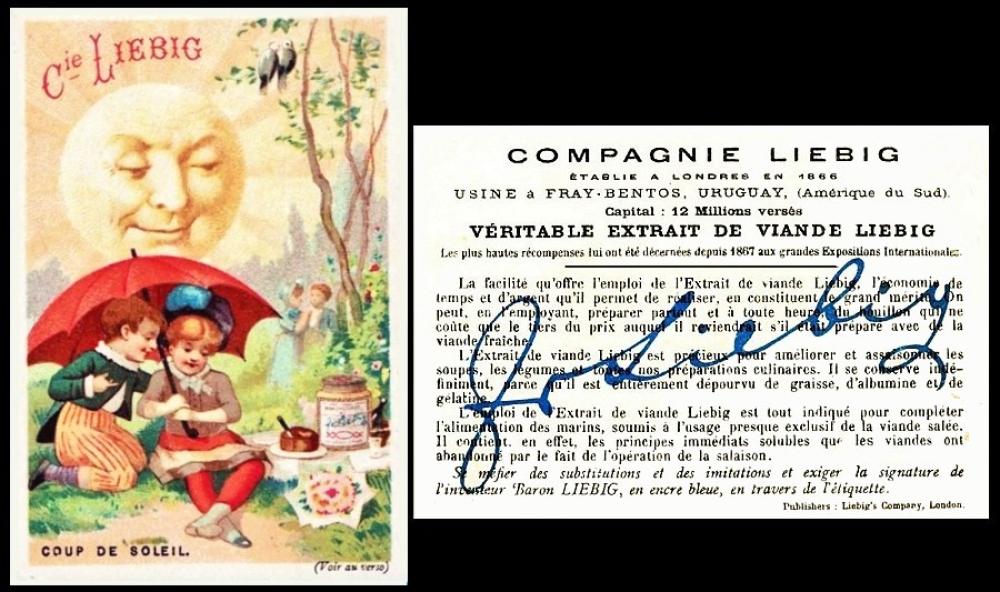
Liebig [trade : meat extract : O/S - South America] "Soleils" / "Scenes with the Sun" (1875) Un/6 - F.0185 : S.0183
Today`s event records the warmest ever Christmas Eve, which was 15.5°C, recorded at both Aberdeen and Banff in Aberdeenshire, Scotland, in 1931. Now this may suggest that these are neighbouring towns, but there are actually almost fifty miles between them, diagonally opposed on different coastlines - though the road between them is not so straight.
We do know that the whole of that December had been very dry, with many warm days, and, intriguingly, I have found two partial references to the fact that this equalled the record of the highest temperature on Christmas Eve, plus one to the fact that the last time it was that hot was sixty years ago. That would be 1871, oddly, as this seems universally to be listed as being a cold winter across Europe, and presumably the United Kingdom too.
As far as the warmest ever Christmas Day, this was just one degree higher at 15.6°C, and it was recorded at Killerton, in Devon, in 1920. Perhaps then, 1920 was the "only one" of the Christmas Days that occurred in those roaring twenties which was not rainy. Curiously, Killerton is not a town, but a house, near Exeter, which is now owned by the National Trust, but, at the time of the weather record, was still owned, and lived in, by the Acland family - who had been there for almost two hundred years.
As far as the hottest Christmas Day temperature worldwide, that is regarded as being the 33.8°C, recorded in Texas, twice, once in 1955 and once in 2021.
This set was issued in 1875, and only in two countries - in France, as "Soleils" (Scenes with the Sun), and in Germany as "Sonnenbilder" (Pictures of the Sunshine). Neither are cheap, though they do seem to turn up quite a lot and there is a fair chance of finding complete sets, if you don't mind paying a bit for them.
Like yesterday`s card it is a second series to an earlier set with the same title, which has the codes of F.0156 (Fada) or S.0158 (Sanguinetti). However that one is quite different in style, and the sun is just a yellow or orange circle, it has no face. Also the pictures on that are not of children, and, be aware, not for them either, as one is a rather ghastly one of a seal hunt.
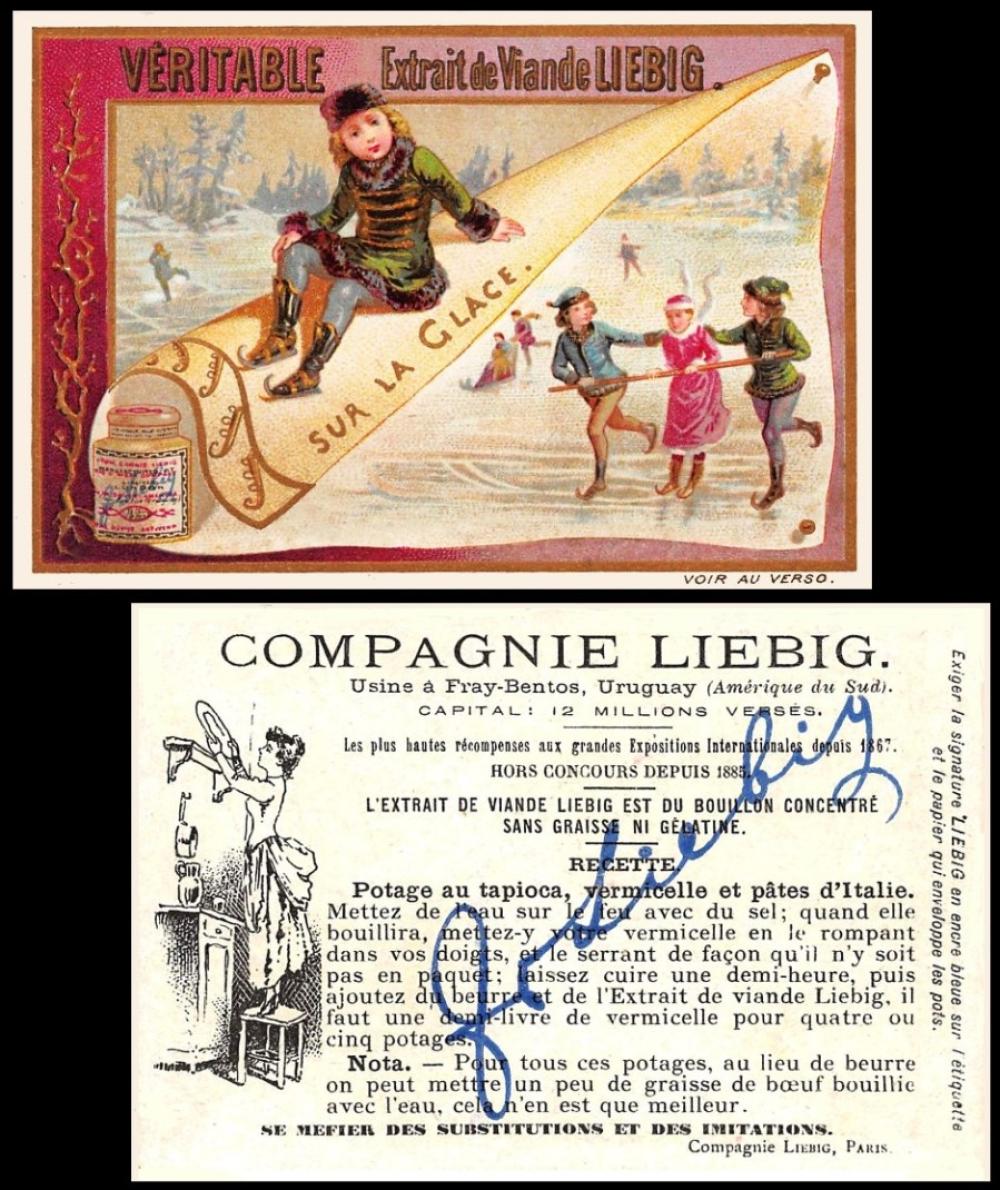
Liebig [trade : meat extract : O/S : South America] "Sports" (1895) Un/6 - F.0430 : S.0428
Now moving swiftly on, let us speak of the coldest Christmases. You have to go a very long way back to find the lowest temperature in the entire British Isles, for that was in 1878, in Gainford, Durham. And the temperature? Well it was minus 18.3 °C.
And, amazingly, Gainford also holds the record for the coldest ever Christmas Eve in the United Kingdom, in 1878 - with exactly the same temperature, minus 18.3 °C.
As far as the coldest Christmas Day of all time in Northern Ireland, Scotland, and Wales, they all happened in the same year, 2010
Altnaharra, in Scotland only just missed equalling that 1871 record, when it fell to minus 18.2°C. The same place also holds, jointly, the record for the coldest ever temperature in the British Isles - minus 27.2°C on the 30th of December, 1995 (it shares that record with Braemar, whose thermometers recorded it on the 10th of January, 1982)
Katesbridge, in County Down, Northern Ireland saw their temperatures plummet to 17.5°C. The town of Katesbridge may be a small place, but it is frequently up there in the weather charts, both for cold in winter and heat in summer, Nobody really knows why, but they think it is because the ground dips all round it which keeps the cold, and also the heat, trapped in the area for longer. But in 2010 there was another Christmas Day record broken in Northern Ireland - with seventeen centimetres of snow laying on the ground. This is most unusual, because Ireland in general has a milder and wetter disposition than the rest of the United Kingdom, and their snow generally comes after Christmas, in January or even February.
Llysdinum, in Wales, was a little bit warmer than the last two Christmas Days, at 16.5°C. This is another small town, but it has a claim to fame which is also weather related, and that is the success of Llysdinam Hall. For although it was built for its access to a well stocked, fishing river, later generations realised that the cool climate would be ideal for plants, and this led to it becoming the world famous Llysdinam Gardens
Of course none of these come close to what is regarded as the coldest Christmas Day ever - in Oregon, in 1924, when they recorded minus 53°C
This card may represent ice, but the set is a mixture of scenes. As for why it is called "Sports", the truth is that as it is not titled, we can only guess, and that is almost certainly what the early collectors did, perhaps even with only one or two of the cards to hand. We do know, though, that the full set comprises :
- A Cheval [on horseback]
- En Bicyclette [on a bicycle]
- En Voiture [by horsedrawn carriage]
- Sur la Glace [on the ice]
- Sur la Plage [on the beach]
- Sur l`eau [on the water - a sailboat]
The word "Voiture" is curious to our modern eyes, for in modern dictionaries you will see it is French for car. It really comes from Latin, and it means "to carry", so whichever mode of transport is carrying you along at that time means this word is correct. And it does not necessarily mean to carry a person along, for when we carry a parcel it comes from the same idea, we are transporting, as it were, one thing to somewhere else.
As far as where the versions of this set were issued, it seems to have been a very popular one, for you can find it in Belgian, French, German, Italian, and Dutch. The easiest to find today is the Belgian one, with the German and Dutch being slightly harder. However, they all turn up quite frequently, and often as complete sets.
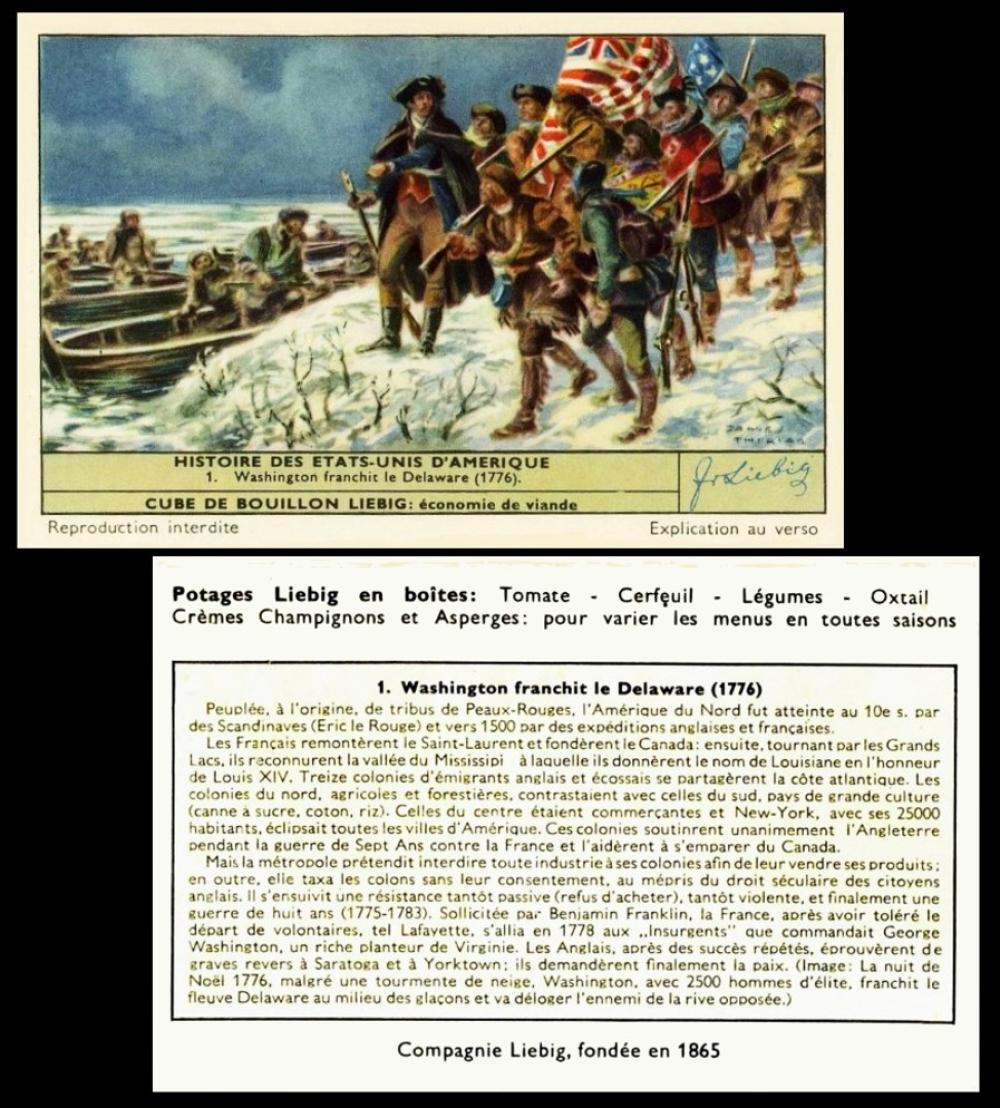
Liebig [trade : meat extract : O/S - South America] "Histoire des Etats-Unis D`Amerique" / "History of the United States of America" (1956) 1/6 - F.1640 : S.1659
This card takes us back to the days of George Washington, and to an amazing event which seems almost to have been forgotten.
He stood and thought. His men were weary, and the people of America were getting disheartened of the way that war dragged on without anything happening, At the start such things drag the people along, either in support or opposition, but in all things a stalemate is reached and that can often be the end, with nothing sorted.
Washingtons`s Army had seen several defeats in 1776, many as they fought in what would one day become the sprawling metropolis of New York. They had been affected by disease, loss of morale, desertions, and interception and capture by the opposite side, which was actually us, Great Britain - though, strangely, many of those who fought for us were German.
As he sat and pondered, George Washington was fairly certain that the British were planning a mass attack. He had looked at maps and had realised the best way for them to do this was to wait until the Delaware River froze over completely and simply march across. Then he suddenly realised that he could do the same, but before the river had frozen solid, by using boats. The more he thought about this, the more he liked the idea. He even had a date rolling about in his head, December the 26th, and even better, frequent reports that civilian skirmishes at a place called Trenton were both weakening the morale and dragging them away from guarding the front line.
Late on December 25, whilst the weather was appalling, with strong wind and a mixture of snow, sleet, and driving rain, they set out. They reached the Delaware river at about 11 pm, to find it was much more frozen than had been imagined, with large areas of ice that had to be navigated along the way, and no maps to their whereabouts. However, he did have a secret weapon, for some of his men were sailors in their pre-military days, and they were able to tackle the frozen river with skill and good judgement, though several boats came close to sinking, and some were damaged by striking the contorted edges of the ice. On the other hand, many of the soldiers had never seen water, and were not able to swim, but even those who fell overboard into the frozen river were somehow clasped and rescued. And adding to the chaos were the horses, who were also on the boats.
All of this made the crossing much longer than expected, and they did not land until almost 3 am. Then it was not until an hour after that that they started marching towards their target. They were also at half strength, for two of his sections had failed to get into the water at all and remained on the opposite shore.
In the end, despite this, George Washington won the battle, and also took many prisoners, along with supplies and weaponry. This served to raise the morale amongst his men, and almost certainly shortened the war.
This card is a more modern Liebig than we generally show, and each card is numbered. The full set comprises :
- Washington franchit le Delaware (1776) [Washington Crossing the Delaware]
- Achat de la Louisiane (1803) [the Louisiana Purchase - the treaty which transferred ownership of the Louisiana Territory from France to the United States]
- Les troupes des Etats-Unis A Mexico (1847) [American troops in Mexico, during the Mexican-American War]
- Lincoln visite Richmond (1865) [:Lincoln visits Richmond, Virginia, the Confederate Capital during the American Civil War]
- Lafayette, nous voici ? (Juin 1917) [oddly, this commemorates General Pershing, leader of the American Expeditionary Force, in France, during the First World War,, pausing at Lafayette`s tomb and declaring that they would fight in his name - it translates as "Lafayette, we are here" - though there is some debate as to whether it was actually said by one of his staff, or even one of his men)
- A bord du Missouri (1er Septembre 1945) [the Japanese surrender in the last days of the Second World War, the formal surrender taking place on the U.S.S. Missouri, in Tokyo Bay]
Our card is the Belgian version, but it was also issued in Germany (as "Geschichte der Vereinten Staaten"), and the Netherlands (as "Geschiedenis van de Verenigde Staten").
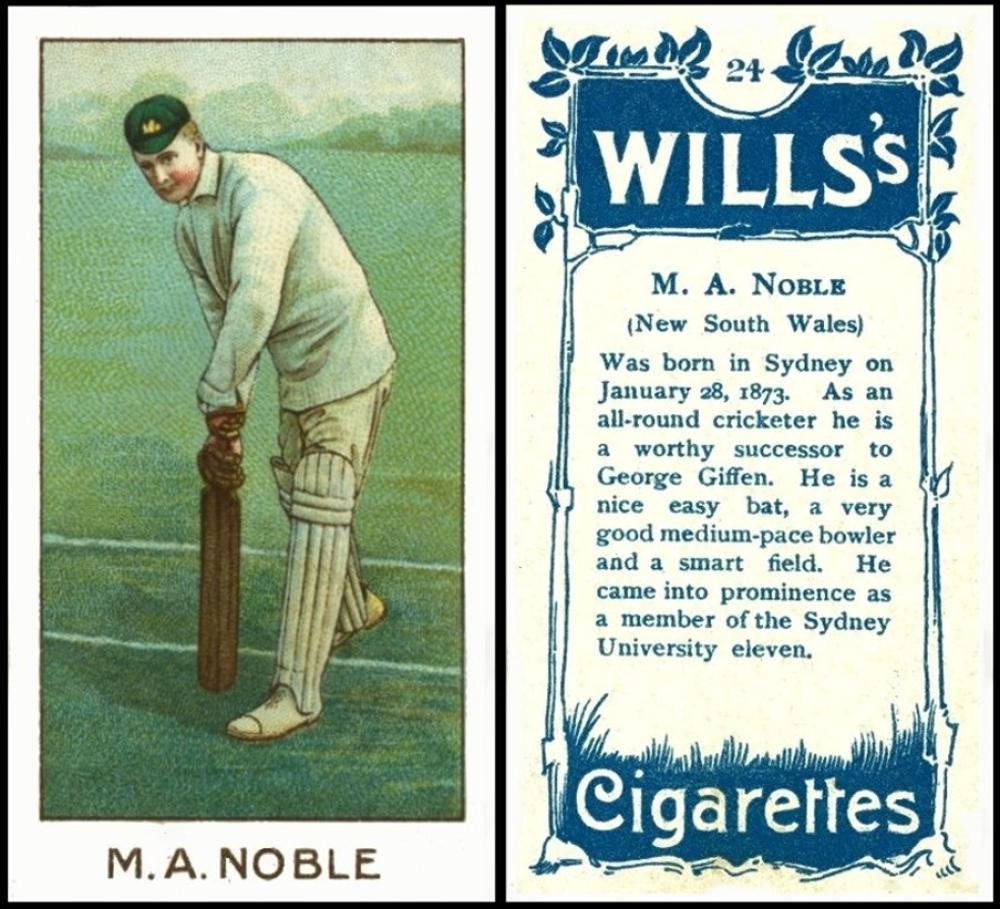
W.D. & H.O. Wills [tobacco : UK : Bristol] "Cricketer Series" - untitled (1903) 24/25 - W675-347.2 : W62-221.2 : W/59.B
So, to close out our week, we have this man, M. A. Noble, or, more correctly, Montague Alfred Noble - not because it is his birthday, but because today, in 1905, (two years after he appeared on this card), he scored two hundred and eighty one runs over the course of an innings lasting six hours and fifteen minutes - including twenty-one "fours". The match was New South Wales versus Victoria, and New South Wales were, understandably, the victors - with a score of eight hundred and five runs.
In total, he scored almost fourteen thousand runs, made almost forty centuries, and took over six hundred wickets between 1893 and 1920, when he retired and became a banker. He also used his spare time to write cricket books, which are much sought after today. He did not leave the game entirely though, for he continued as a commentator, and also a coach for junior players.
He died in 1940.
Now this card took me some considerable time to find in our reference books. I eventually tracked it down in our original World Tobacco Issues Index, under Wills Section 3, devoted to Australian issues, where it appears as part of a group of seven sets going by the adopted title of :
CRICKETER SERIES. (A) Sm. ... W62-221
2. 1903 issue. Untitled. Australian and English players. Nd. (25). Back in blue, inscribed "Wills`s Cigarettes". See W/59.B
That W/59.B led me back to the original Wills reference books, where I had started but bogged down in the only set called "Cricketer Series", even though that dated from 1901 and was coded W/8. The problem with that listing was that updates to it appeared in parts I, II, III, and V - and I was getting completely confused. Having the W/59 code was much better, and took me to the right set, listed as "Cricketers - Australian issues". though, admittedly, these appeared in more than one of the original Wills reference books as well, parts III, IV, and V. However, luckily, the latter two concern different sets to ours.
Part III is the basic listing and covers eleven sets. One day I will use one of those groups as a Card of the Day and upload the entire eleven, plus all the updates. The heading to all reads "59. CRICKETERS - Australian Issues. Under this heading it is proposed to group all the "Cricketers" series issued in Australia prior to 1918. Figure 41 contains illustrations of the front and one sample of all the different backs of each issue". Our set is described as :
B. 25 AUSTRALIAN AND ENGLISH CRICKETERS (adopted title). Numbered. See Fig.41.B. Fronts lithographed in colour. Backs in blue. Issued 1903.
In our updated World Tobacco Issues Index, it appears as :
CRICKETER SERIES. (A) Sm. ... W675-347
2. 1903 issue. Untitled. Australian and English players. Nd. (25). Back in blue, inscribed "Wills`s Cigarettes". See W/59.B
This week's Cards of the Day...
This week we are celebrating International Migrant Day, which has a double theme this year - honouring the contributions of migrants - and - respecting their rights.
During my research, the strangest thing I discovered was that there is not a standard, universally accepted definition for the word migrant. This means that each country in the world is allowed to deal with migration however they see fit, and also determine how legitimate the reason is for the person wanting to leave. If, therefore, they are leaving because they want to pursue their dreams in a way that is against the rules of their country, they are likely to be arrested, or even killed, rather than be allowed to go.
As for what a migrant is, all countries accept that this is someone who wishes to leave where they were formerly living, whether they agree with the reason why, or not. There are also common definitions of universally accepted migrants, these being people who have a job all set up on the other side, or those who have already been accepted at college or university. Neither of these categories cover people who are smuggled, or who leave on the off chance of hoping to gain employment or find a seat of learning; once these have made their decision to leave, they just go, with no support, and often nobody knowing where they are, or what is happening to them, at any time. And whilst some are lucky, and end up claiming asylum, and becoming integrated into a country where they are allowed to be who they dreamed to be, some simply get lost along the way, or intercepted, and are never seen again.
Saturday, 14th December 2024

Here we have Alphonso Boyle Davies, who currently plays for Bayern Munchen, in Germany.
He is here for two reasons. Firstly, because he is an ambassador for the United Nations refugee agency. And secondly because he is also a migrant, born on November 2nd, 2000, in Buduburam, Ghana, to parents who were already refugees from their native Liberia, Then, when he was five years old, they relocated to Edmonton in Canada, where he, and maybe his parents, gained their Canadian citizenship in July 2017.
He had already started playing football, firstly through Free Footie, a club for inner-city children who love the game but cannot afford the equipment to improve their skills, nor the membership to any other clubs. Also provided by the scheme is free transport to their games. Because of this, his talent grew, and was eventually spotted by local club Edmonton Internationals. From there he was picked up by the Edmonton Strikers, and they paved the way for him to join Whitecaps Academy, the youth arm of the professional club Vancouver Whitecaps.He started there in 2015, at the age of just fourteen, and slowly moved up their ranks until he became the youngest person ever to sign a football contract, at the age of fifteen years, three months.
In July 2017 he became the youngest ever player in the Canadian national soccer team. After that, he broke many records, youngest player to score a goal, both in the league, with the Vancouver Whitecaps, plus internationally, and at World Cup level.
His first card was issued in 2018, by Chevron, who were the official petrol station of the Vancouver Whitecaps - however there is an error on the card, for his birth date is given as 11/02.00, which is incorrect.
Our set is given as 270 cards but there are only 135 cards in the base set, the others are kind of subsets, "Max Power", eighteen cards featuring the most powerful players and giving their body mass index - "Supersonic", twenty-seven cards of the fastest players - and "Winner", eighteen cards of the players with the most trophies, whether that be league or international.
In addition there are holograms, and five parallel sets which are each a different colour, blue, green, gold, purple and red - these are additional to the 270 cards quoted,
And, by the way, our man also appears elsewhere in this base set - as card 160, on his own - and card 233, where he is teamed with Jamal Musiala.
Sunday, 15th December 2024
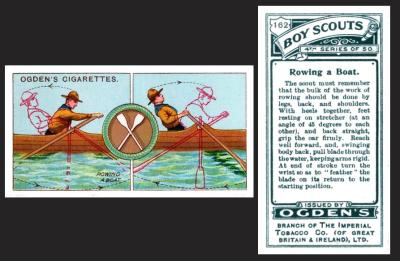
Here we have the rowing boat, which most people now connect with migrants, though, in actual fact, the most common way of migrating is by foot, trudging along, sometimes for many miles, with little shelter along the way, carrying their most important items, or maybe just their memories.
Now it is very remiss of me but we seem not to have a home page for this complex group of sets - something which I will add to my to do list.
I have found out that we used the first set as a Card of the Day on the 27th of July, 2022, so that is where it will go, and I have started it, but run out of time tonight.
Once it is there then it will contain the listing of all the sets and the links out to the constituent parts, where just the relevant sections of our reference books for that one group will appear.
This section, the fourth series, by Ogden, was not issued by any other company (whereas other sets of the series were) - nor were there different printings (some sets being reprinted in in other colours). It is therefore described in our original Ogden reference book (RB.15), issued in 1949, as simply :
44. 4th Series of 50. Numbered 151-200. Backs in green. Issued 1913
By the time of our World Tobacco Issues Index, the listing simply read :
4. "4th Series of 50". Nd 151-200. Back in green ...
And in our updated version,
4. "4th Series of 50". Nd 151-200. (50). Back in green
Monday, 16th December 2024
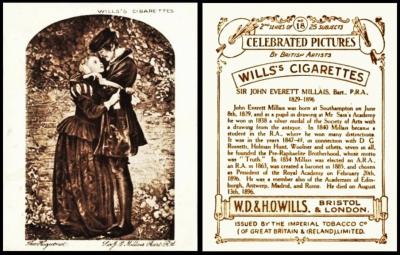
Here we have the first major group of people to migrate, the Huguenots, or French Protestants, though they also came from Belgium. They departed, en masse, throughout the sixteenth, seventeeth and eighteenth centuries, under penalty of death, simply because of their religion, which remains one of the largest reasons for migration to this day. As they became established, they shared with us their skill at silk weaving, which was almost a forgotten trade over here, as well as their expertise in many different arts, from manufacturing and repairing decorative objects, to the architecture of our palaces and homes, and the way their interiors were dressed.
This card is described as "The Huguenot", but that is not the full title of the work, it ought to read "A Huguenot, on St. Bartholomew's Day, Refusing to Shield Himself from Danger by Wearing the Roman Catholic Badge".
It is also a painting with a dark secret, for it is not just a pair of young lovers, the girl is trying to beseech her boyfriend to wear the white armband that she has made him. The reason for the armband is that the Huguenots, French Protestants, were under attack, and a decree was made that on St. Bartholomew`s Day, August 24, 1572, all that were seen not wearing the white armband denoting that they were Catholics, would be killed. Approximately almost a quarter of a million were, when all parts of France were added together, but statistics then were not so well gathered, and in many areas, especially rural, we can only have but guesses.
Even more that than, this painting tells another story. For the fact that she is giving him an armband must mean that not only is she Catholic, and so breaking every rule by becoming his lover, but that the band is hers, but she would rather die herself than let him be killed.
The original painting is in colour, and it is part of a private collection. We do not know why Wills chose to depict it in brown, but at the time of issue a lot of other cards rendered great works into monotone, and Wills was no stranger to doing it - including their 1913-14 "Art Photogravures", which includes another of the works by this artist, John Everett Millais, namely "The Boyhood of Raleigh". However, in August 1930, that painting did appear at last in its natural hues, as part of the sectional series "A Famous Picture".
Reportedly the artist was working on a picture of two lovers and then went to see the opera "Les Huguenots" at Covent Garden, which recounts the fatal event from the viewpoint of two fictitious lovers. However the opera was at Covent Garden in 1836 and our painting was not done for at least ten years, not finished until 1851, and then exhibited at the Royal Academy of Arts in 1852.
As far as our set, this is first described in our original reference book (RB.16) to the issues of W.D. & H.O. Wills, part IV, (which is actually Parts 1-3 revised and Part 4), written and complied by Edward Wharton-Tigar, and published in 1950. The entry reads :
CELEBRATED PICTURES by British Artists. Large cards, size 80 x 62 m/m. Fronts printed by gravure in brown and white. Backs in brown with descriptive text. Home issues 1916.
165. 25. "A Series of 25 Subjects". Numbered 1-25. Two grades of board (a) white (b) cream. Colour of backs varies from light to dark brown and marked differences can be noted in size of lettering on some cards.
166. 25 ""2nd Series of 25 Subjects". Numbered 1-25.
Now when these books were long out of print, but still being requested, they were reprinted as a hardback volume containing all the parts, and, at the same time, two tables of issue dates were added, which had formerly appeared in the Wills Works Magazine. These reveal that the first series of our set was issued in February 1916, and the second series followed straight on in November 1916. However this second series had an extraordinarily short shelf life, as they were replaced the following month, December 1916, by the set of "Punch Cartoons". Now, oddly, there is only one date for that set, and yet there were two series - this probably means that they followed straight on and it was not thought worth recording the second section`s actual issue date, but yet they did record both parts of ours.
By the time of our original World Tobacco Issues Index, the sets were recorded as simply :
CELEBRATED PICTURES. Lg. Brown Gravures. Nd. ... W62-73
1. "A Series of 25".
2. "2nd Series of 25".
However there were a few omissions here, which were rectified in our updated version of this volume, which catalogues them as :
CELEBRATED PICTURES. Lg. Brown Gravures. Nd. ... W675-106
1. "A Series of 25 Subjects" Backs in (a) dark brown (b) orange brown. Length of captions on front differs between the two printings, but not consistently.
2. "2nd Series of 25 Subjects".
Tuesday, 17th December 2024
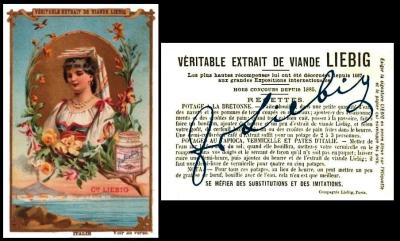
This set really lives up to its name, and it must be said that the cards are as beautiful as the ladies. However, it was chosen because there is a very wistful expression on the face of the lady in the frame as she looks down at her homeland - and, tellingly, when the card was issued, in 1887, it was amidst a great exodus from Italy to other countries, some thirteen million people choosing, quite voluntarily, to migrate. As for why, strangely, it was not persecution on any grounds, simply that they were impoverished and believed that life might be better on other shores.
This mass relocation started in 1880, and grew steadily larger until almost a million were leaving every year - and it only ended with the First World War, though it may be more the case that the Italian government had a bit more to do after that than sit and record the data of people who simply went away peacefully.
Most of these Italians went to America, and made families that may have interbred but in which the Italian genetics remain still strong today. Many singers and actors have Italian heritage, and most can trace it down to someone who migrated at this time.
You can imagine the allure of America, but this was not the Country which took in most Italians, that honour goes, oddly, to Brazil and to Argentina, which is another reason for us to use this card.
This is a six part set, and the other cards are :
- L`Egypte [Egypt] - this being an ancient beauty, possibly Cleopatra?
- Espagne [Spain]
- Italie [Italy]
- Le Japon [Japan]
- Russie [Russia]
- Le Tyrol [Tyrol, Austria]
Curiously, it seems only to have been issued in two of these countries, France (which is where our example comes from), and Spain (which is very scarce). This may be explained by the fact that Japan, Russia, and Egypt were not customers of Liebig, but we know that cards were issued in Italy, and Germany, if not Austro-Hungary, which was where the Tyrol was at that time located.
We can perhaps explain the use of Japan though, because in the preceding years there had been a big trend towards collecting and admiring Japanese objects and ways of life, which had started in the 1870s. In fact, Liebig issued several sets featuring Japan.
Wednesday, 18th December 2024
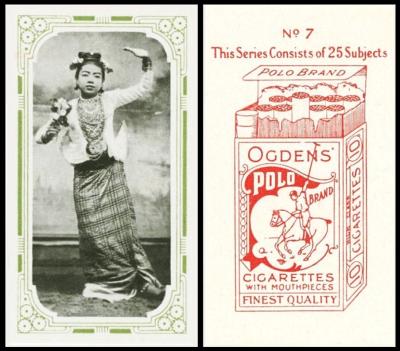
The reason for this card was that people from India form the highest proportion of migrants coming to the United Kingdom - a quarter of a million in 2023 alone. Most of these, over half, had a job already set up, and just under half had a confirmed space at a University or College. However almost ten thousand had neither, and there were also many illegal crossings for which the reason will probably never be known.
A little research has shown that the first Indians started coming to Britain in the seventeenth century, when Europeans reached their shores. Records state that Peter Pope was the first Indian to be baptized in London, on the 22nd of December 1616, two years after the little fourteen year old Bengali child had been brought across by a chaplain in the East India Company., mainly because he showed such skill at learning English and also Latin. The baptism seems to have been a lavish ceremony, which even the Lord Mayor of London attended, and, even more strangely, his new name, Petrus Papa, was actually chosen by the King, James I. As for what happened after that, we know that he became an interpreter and translator, and published at least one book, and then he decided to return to his homeland, in order to try and convince his people that Christianity was the way forward. Unfortunately it seems that this was unsuccessful, and when his mentor went out to India to try to find him he could not.
This set is first listed in our original Ogdens reference book (RB.15, published in 1949) as :
104. 25. INDIAN WOMEN (adopted title). Size 63 x 36 m/m. Fronts per Fig. 50, printed by letterpress; portrait in black and white, framework in green. Backs in red, with illustration of "Polo" packet. There are two printings :-
A. Framework on fronts in apple green. Backs on white board
B. Framework on fronts in emerald green. Backs on cream board.
Issued in the East, between 1910-1915
Now it does not say so here, but the cards are actually numbered, on the top of the reverse. This means that we can tell you the card chosen as the illustration for Fig.50 was card number 24. And there is a pictorial checklist of all the cards at the Trading Card Database/OgdenIndianWomen
Now this original Ogdens reference book lists the cards in alphabetical order, and includes their overseas issues too. The same is not true of our World Tobacco Issues Indexes, which stove the sets off into groups, and ours is therefore in Ogden`s section 5 - "Export issues without I.T.C. Clause". It also tells us that the cards were "issued through B.A.T. - in Burma, India, Ceylon and Malaya", so I might find more information in our reference book RB.21. Section 5 is also split into smaller parts, and our set comes under 5.C, along with all the other issues branded for "Polo" Cigarettes. There is also, unusually, a lot more information about the cards here - which suggests that a collector came forward and added those missing bits. The listing reads :
INDIAN WOMEN (A). Sm. 63 x 36. Picture in black and white, framework in green. Back in red, Nd. (25). See RB15/104 ... O/2-207
A. Framework on front in apple green. Back with "Polo" packet, 45 m/m high.
B. Framework on front in emerald green. Back with "Polo" packet slightly larger, about 45 1/2 m/m high.
When we get to our updated World Tobacco Issues Index though, there is a big change, which led to me thinking they were not recorded, but they are, as :
BURMESE WOMEN (A). Sm. 63 x 36. Picture in black and white, framework in green. Back in red, Nd. (25). Previously recorded as "Indian Women". See RB115/104 ... O/100-740
A. Framework on front in apple green. Back with "Polo" packet, 45 m/m high.
B. Framework on front in emerald green. Back with "Polo" packet slightly larger, about 45 1/2 m/m high.
This led to more investigation, and to the fact that most of the Burmese migrate to Thailand, with which they share a border. Thailand is also promoted as being a very modern place, with lots of easy money to be made at bars and clubs, etc. To some extent this is true, and as the country continually modernises there is much work to be had on construction sites, but it is not easy. and working in the bars and clubs can sometimes turn out to be very different than imagined. Most of the migrants are young men, who either do not want to get involved in the armed forces, or whose way of life falls foul of their religion.
Not many Burmese come to the United Kingdom.
Thursday, 19th December 2024
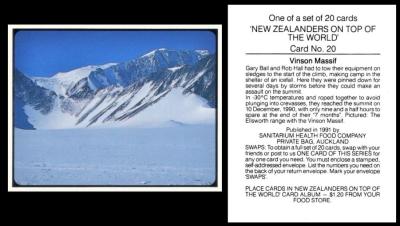
Here we have the Vinson Massif, a large mountain which is thirteen miles long and eight miles wide. It is part of the Ellsworth Mountains, and it was only discovered in 1958, by aircraft belonging to the American Navy - it was later named, officially, after Carl G. Vinson, the congressman for Georgia, but also an outspoken, long-term supporter of Antarctic exploration.
After this card was issued there was a discovery, namely that it was two mountains, so these have been split into the Vinson Massif and Mount Vinson. And if you are wondering what a massif is, it is one of the groups of risen land that together add up to making an entire mountain range.
As for why this card is here, well the reason is that Antarctica is the only country in the world that has never had a single migrant apply to live there.
In fact it has never had a permanent inhabitant either, the only people there are temporary, they are either tourists on holiday, calling briefly in, or scientists and researchers who come for a short stay, six to seven months of what is considered the summer, and then go back to work on their findings. And if anyone did apply to live there, they would find an alien world, with no towns, no infrastructure, and no jobs, except, maybe, for those six or seven months when the researchers come, though they keep themselves to themselves in the research hubs and everything they need is brought with them.
New Zealand, where this card was issued, has quite some claim to fame regarding Antarctica, and not just because it was the birthplace of Sir Edmund Hillary, the mountaineer and also the builder and planner of Scott Base, from which the 1957 Commonwealth Trans-Antarctic Expedition started out.
Since 1923, New Zealand has also controlled the Ross Dependency, though this area was first claimed, in 1841 by the United Kingdom.
Even earlier than that it is believed that the first person to stand on the Antarctic ice, in January 1895, was Alexander von Tunzelmann, a New Zealander who was a crew member of the Norwegian whaling ship, the Antarctic. Whether or not it was actually his foot that first slithered out along the ice is not proven, but he was definitely amongst the first group who disembarked.
This card celebrates, and remembers, Gary Ball and Rob Hall, who climbed Mount Everest in 1990 on his second attempt, along with Peter Hillary, the son of Sir Edmund Hillary. Gary Ian Ball was also a survival training expert at Scott Base in the late 1970s, and he died in 1993 on the Himalayan mountain Dhaulagiri - whilst Robert Edwin Hall was actually the subject of the 2015 film Everest, taken from a book written about his life and death, on Everest, in 1996, called "Into Thin Air".
Peter Edmund Hillary is still alive at the time of writing.
This card is only recorded in our Australian and New Zealand Index, part II, or RB.33, which was published in 1993. That is why the code looks a bit different. It was also a local set, only issued in New Zealand and not Australia, so it is in section 1 of the Sanitarium listings, under "(e) - Dated cards". It is, however, listed with a different title, namely :
1991-1 New Zealand on top of the World. 73 x 57. Nd. (20) .... SA2-89-10
The code at the front tells us that it was the first set to be issued in 1991, there being four others, these being, in order of issue :
- 1991-2 Saving the World`s Endangered Wildlife (20 cards - measuring 73 x 57)
- 1991-3 New Zealand Disasters (12 cards - but slightly larger at 97 x 75 m/m)
- 1991-4 Airliners of the 90s (12 cards - but split into two sizes - 97 x 75 m/m and 101 x 79 m/m)
- 1991-5 New Zealand Inventions and Discoveries (12 cards - 97 x 75 m/m)
Friday, 20th December 2024
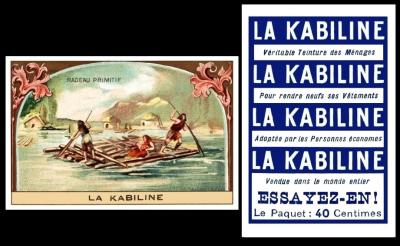
To close we go right back to the start of migration, and to prehistoric man.
Now he was happy enough crawling about on all fours within a short distance from his cave, and then, somehow, he learned to stand upright. At about the same time, along came ambition.
That led him to travelling further distances, and, eventually, to the edge of the hard surface that he could walk on and to the start of something wet and cold that shifted shape about his feet. I think that there must have to have been more land, within his sight, but across that water, giving him the idea of something to aim at, the spur of something else he needed to explore.
He could not walk far on the water though, he sank in, and it was perhaps cold and unpleasant. He may have tried to swim, or flounder, but with little success. Then he sat on a log and thought, and probably, some time later, as he shifted position and ended up with one leg on each side of the log, maybe I could sit on here, and propel it by splashing my feet and arms.
It probably worked, a bit, but he got tired, and let the log float back into the shore. We do not know when he came up with the idea of using branches as propulsion, but it was the obvious choice. And so one day, he woke up, and paddled across, and so became the first person ever to migrate to a new land.
The image on this card shows a later development, for he is standing, upright, and he has a larger raft, logs lashed together with reeds. He also has a companion, and a wife and child. and, to spare the blushes of the consumer at the time the card was issued, they have somehow found clothes from somewhere.
As far as "La Kabiline" it looks like it was a trademark. We do know that the product was a dye, and that each shade cost forty centimes; in addition the dyeing process was easy and fast, only taking twenty minutes. However I have been unable to find a company name. I have an address, but from the late 1940s, that is 64 - 73, Rue des Chantiers, Versailles. This makes the period of operation from at least 1895 until 1948, quite a time to have left such a little trace.
And so now I will embark on next week`s newsletter. I am still looking like the cousin of a leopard, but the spots are a bit less itchy.
That newsletter will take us into January - and it will be the final one of 2024.
Next year we will try to discover more centenaries, and also bring you unusual facts. But if anyone is a specialist in a certain subject and would like to suggest either a theme of the week, or a diary date, please do. We have had many such suggestions this year, and it has been most interesting and educational to me. And hopefully to you as well......
